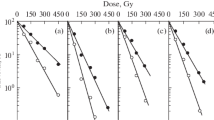Summary
It has previously been shown that radioinduced organic radicals can be repaired by hydrogen donation from glutathione (GSH) and this repair is in competition with oxygen (damage fixation).
In this paper the influence of exogenous glutathione on the radiation response of the enzyme alcoholdehydrogenase (YADH), DNA in vitro, andE. coli B/r cells has been investigated.
GSH is observed to protect YADH essentially by free radical scavenging mechanisms in both presence or absence of oxygen. The same mechanism seems operate in the radioprotection afforded by GSH to DNA in vitro.E. coli B/r cells are protected at higher extent by GSH than its oxidized form (GSSG); the possibility that GSH penetrate into bacterial cells more easily that GSSG can explain their different behaviour.
None of the three systems studied has provided definitive support for the occurrence of the hydrogen donation reaction in the radioprotective mechanisms of GSH versus biomolecules and bacterial cells.
Similar content being viewed by others
References
Alexander P, Bacq ZM, Cousens SF, Fox M, Herve A, Lazar J (1955) Mode of action of some substances which protect against the lethal effects of X-rays. Radiat Res 2: 392–415
Badiello R, Tamba M (1974) The application of radiation chemistry techniques to enzyme studies. Acta Vitaminol Enzymol 28: 306–316
Badiello R, Tamba M, Quintiliani M (1974) Primary and secondary radicals in the radiation-induced inactivation of yeast alcoholdehydrogenase. Int J Radiat Biol 26: 311–319
Baker MZ, Badiello R, Tamba M, Quintiliani M, Gorin G (1982) Pulse radiolytic study of hydrogen transfer from glutathione to organic radicals. Int J Radiat Biol 41: 595–602
Behar D, Czapski G, Rabani J, Dorfman LM, Schwarz HA (1970) The acid dissociation constant and decay kinetics of the perhydroxyl radical. J Phys Chem 74: 3209–3213
Billen O (1967) Modification of the release of cellular constituents by irradiatedE. coli. Arch Biochem Biophys 67: 333–340
Blok J, Loman H (1973) The effect ofγ-radiation in DNA. In: Ebert M, Howard A (eds) Current topics in radiation research quarterly, vol 9. North-Holland Publishing Company, Amsterdam, pp 6165–245
Cancelliere G, Giacchi P, Misiti-Dorello P, Quintiliani M (1975) The influence of agents that enhance lethal effects of radiation on the damage to bacterial membranes by X-rays and ultraviolet light. Radiat Res 64: 593–601
Cowie DB, Roberts RB (1955) Electrolytes in biological systems. In: Woods Hole Mass Symposium pl. Chem Abst 50: 14050
Davies JV, Ebert M, Quintiliani M (1979) Fast intermediate reactions sensitizing alcoholdehydrogenase to radiation. In: Moroson HL, Quintiliani M (eds) Radiation protection and sensitization. Taylor and Francis Lts, London, pp 87–93
Dertinger H, Jung H (1970) Molecular radiation biology. Springer-Verlag, Berlin Heidelberg New York
Edgren M, Larsson A, Nilsson K, Révész L, Scott OCA (1980) Lack of oxygen effect in glutathione-deficient human cells in culture. Int J Radiat Biol 37: 299–306
Edgren M, Révész L, Larsson A (1981) Induction and repair of single-strand DNA breaks after X-irradiation of human fibroblasts deficient in glutathione. Int J Radiat Biol 40: 355–363
Gorin G, Quintiliani M, Airee SK (1967) The inactivation of alcoholdehydrogenase by X-rays and the dose-modifying effect of some added substances. Radiat Res 32: 671–684
Gualandi G, Pini L (1974) Tecniche di irradiamento di sistemi enzimatici. Quad Area Ricerca Emilia-Romagna 5: 123–125
Harrison AP Jr, Bruce AK, Stapleton GE (1958) Influence of X-irradiation on potassium retentivity byE. coli. Proc Soc Exp Biol Med 98: 740–743
Held KD, Harrop HH, Michael BD (1982) Reaction kinetics of sulphydryl-containing compounds and oxygen with irradiated transforming DNA. In Abstracts of papers of the thirtieth annual meeting of the Radiation Research Society, Salt Lake City. Academic Press, New York, p 26
Howard-Flanders P (1960) Effect of oxygen on the radiosensitivity of bacteriophage in the presence of sulphydryl compounds. Nature 186: 485–487
Hutchinson F (1961) Sulphydryl groups and the oxygen effect on irradiated diluted solutions of enzymes and nucleic acids. Radiat Red 14: 721–731
Jocelyn PC (1972) Biochemistry of the SH groups. Academic Press, London
Merrick TP, Bruce AK (1965) Radiation response of potassium efflux inMicrococcus radiodurans andSarcina lutea. Radiat Res 24: 612–618
Quintiliani M, Badiello R, Tamba M, Esfandi A, Gorin G (1977) Radiolysis of glutathione in oxygen-containing solutions at pH 7. Int J Radiat Biol 32: 195–202
Quintiliani M, Badiello R, Tamba M, Gorin G (1976) Radiation chemical basis for the role of glutathione in cellular sensitivity. In: Modification of radiosensitivity of biological systems, IAEA, Vienna, Austria, pp 29–37
Révész L (1969) Interplay between natural and artificial radiation protection. In: Radiation damage and sulphydryl compounds, IAEA, Vienna, Austria, pp 125–132
Rodgers MAJ, Powers EL (1981) Oxygen and oxy-radicals in chemistry and biology. Academic Press, New York
Scholes G (1978) Primary events in the radiolysis of aqueous solution of nucleic acid and related substances. In: Hutterman J, Kohnlein W, Téoule R (eds) Effects of ionizing radiation on DNA. Springer-Verlag, Berlin Heidelberg New York, pp 153–170
Vergroesen AJ, Budke L, Cohen JA (1964) Factors affecting the radioprotection of tissue cultures cells by sulphydryl compounds. Nature 204: 246–247
Willson RL, Greenstock CL, Adams GE, Wageman R, Dorfman LM (1971). The standardization of hydroxyl radical rate data from radiation chemistry. Int J Radiat Phys Chem 3: 309–320
Author information
Authors and Affiliations
Rights and permissions
About this article
Cite this article
Simone, G., Tamba, M. & Quintiliani, M. Role of glutathione in affecting the radiosensitivity of molecular and cellular systems. Radiat Environ Biophys 22, 215–223 (1983). https://doi.org/10.1007/BF01323711
Received:
Accepted:
Issue Date:
DOI: https://doi.org/10.1007/BF01323711




